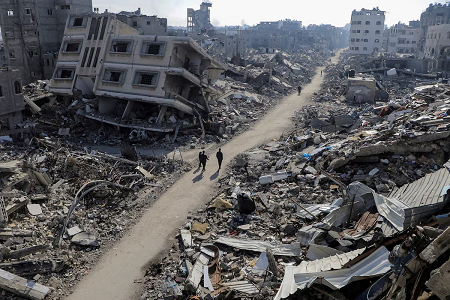Envisioning Gaza Reconstruction

The previous issue of Land Times/أحوال الأرض reported on efforts to put a number on the material costs of Israel’s destruction of Gaza over time, with a focus on the period of the ongoing genocide. While the human, material and environmental costs of Israel’s colonization of the country may defy quantification, the context of recent history is essential to the task. However, as with all colonizations, it is a daunting tale of incalculable loss to the Indigenous People.
Daunting, too, is the prospect of rebuilding Gaza’s moonscape of rubble. Israel’s violent creation in 1948 truncated the Gaza Governorate to create the ‘Gaza Strip,’ which its colonial forces—notably Ariel Sharon’s infamous Unit 101—attacked repeatedly before its 1967 military occupation. Thereafter, the implantation of agricultural settler colonies desiccated the freshwater table with intensive agriculture by 2006, while choking the natural water supply by siphoning and damming the aquifer’s recharging capacity. Then, serial Israeli military operations across Gaza razed and bombed the built environment in 2000–04, 2008–9, 2012, 2014, 2021, 2022, May 2023 and continuously since October 2023 have destroyed the built environment: homes, residential buildings, factories, utilities, roads, office buildings, educational facilities, agricultural infrastructure, recreational facilities, entire cities.
Much of the literature on physically rebuilding Gaza calls for, or assumes political conditions conducive to development in any reconstruction scenario. However, the presence of an apartheid state conducting genocide against the Indigenous Palestinian People across the territory is the central obstacle—and central injustice—that must end to entertain any vision of the future.
If one were to divine how such a reconstruction could be carried out, the integrated plan needed would have to learn from the past. Ironically, the presumed actors in such a recovery scheme involve the very institutions that are liable for the litany of crimes committed there: the United Nations, European Union, international contractors and Israel. Past lessons also instruct us how also the Palestinian Authority has played a negative role in previous reconstruction attempts.
After Israel’s 2014 war on Gaza, the temporary Gaza Reconstruction Mechanism (GRM) granted Israel full control of the construction and reconstruction of Gaza under temporary agreement of the Palestinian Government as brokered by the UN. That arrangement predictably failed to rebuild Gaza, but rather normalized Israel’s siege and further institutionalized the Israeli blockade and deepened people’s suffering.
Parallel to GRM, the Palestinian Consensus Government formed the National Team for the Reconstruction of Gaza (NORG) to liaise with, track and monitor the reconstruction work across ministries. NORG was designed for: (i) prioritization and planning, (ii) policy guidance, (iii) implementation support, (iv) performance management, (v) coordination,
(vi) financing and (vii) communication. However, Palestinian Authority (PA) did not prioritize NORG, and it disintegrated.
With the genocide still unfolding, the PA has not yet announced any reconstruction-governance structure, which usually follows consultations with donors after the war’s end. Nonetheless, numerous dialogues are taking place while diverse actors, with Palestinians being the most relevant among them, position for the eventual day after.
With imaginable local capacities, just removing the 42 thousand tons of rubble, riddled with unexploded bombs, dangerous contaminants and human remains, to make way for reconstruction this time would take at least 15 years and would costs as much as US$700 million. The cost of reconstruction is estimated in the tens of billions.
Among the experts on reconstruction and post-conflict societies, Sultan Barakat and Paul Porteous advise that reconstruction approaches call for leadership to adapt creatively to the nature of conflict, which has blurred the distinction between planning and implementation phases, in a transition scenario whereby occupation ends, sovereignty begins, communities are strengthened, and justice and reconciliation are achieved. International protection, potentially through a UN Transitional Authority for Gaza, could overcome inter-agency competition and conflict, eliminate bureaucratic barriers, engage donors and create the environment needed for local reconstruction beyond infrastructure to encompass identity, social cohesion, political reconciliation, sovereignty, justice, economic development, and cultural renaissance.
Components of the transition would require:
- Immediate ceasefire monitored by international forces and a protection team, Israel’s withdrawal, a no-fly zone, and release of all hostages and detainees.
- Humanitarian aid involving the United Nations Relief and Works Agency for Palestine Refugees in the Near East (UNRWA).
- A hybrid law-and-order sector with local Palestinian police alongside an international police force.
- Self-determination by implementing the two-state solution with territorial integrity of a Palestinian state based on the 1967 borders with East Jerusalem as its capital.
- Palestinian Interim Government.
- Donor funding and reparations.
- National Reconciliation.
This would be achieved with a Gaza Reconstruction Council, stakeholder processes, a Gaza Reconstruction Trust Fund that would build local capacity to achieve justice, accountability, transparency and integrity, long-term strategic planning.
Momin Bseiso envisions reconstruction governance under a sustainable political
solution amid Palestinian unity, without which reconstruction efforts would be futile. A national-level, non-political institution would have to lead and manage disaster response
and reconstruction with active involvement of civil society and local communities, replacing the failed GRM.
In all cases, lessons of history point to consensus on a Palestinian-owned process, through alignment with national planning, and a people centered approach—ensuring that communities and civil society are engaged, and heard. This is consistent with the Paris Declaration on Aid Effectiveness, the first principle of which is ownership and self-determination. The central obstacle to progress remains Israel.
Photo: Palestinians walk past destroyed houses, amid the ongoing conflict between Israel and Hamas, in Jabaliya Refugee Camp, in the northern Gaza Strip, 22 February 2024. Source: Mahmoud Issa/REUTERS.
|